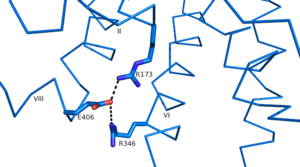Sandbox Reserved 1167
From Proteopedia
| This Sandbox is Reserved from Jan 11 through August 12, 2016 for use in the course CH462 Central Metabolism taught by R. Jeremy Johnson at the Butler University, Indianapolis, USA. This reservation includes Sandbox Reserved 1160 through Sandbox Reserved 1184. |
To get started:
More help: Help:Editing |
Contents |
Class B Human Glucagon G-Protein Coupled Receptor
Glucagon Binding
Research has shown that Class B GCPRs exist in either an open or closed conformation. Transitioning between states, the ECD rotates and moves down towards the 7tm domain. The stalk region of Helix I helps to facilitate this motion of the ECD.
In its open state, the ECD and the stalk region of Helix 1 are almost perpendicular to the membrane surface. In the case of the human glucagon receptor, this open confirmation is stabilized by glucagon binding. In the absence of glucagon, however, the GCPR adopts a closed conformation in which all three of the extracellular loops of the 7tm (ECL1, ECL2, and ECL3) can interact with the ECD. In this closed state, the ECD covers the extracellular surface of the 7tm.
This transition mechanism is consistent with the "two-domain" binding mechanism of Class B GCPRs in which (1) the C-terminus of the ligand first binds to the ECD allowing (2) the N-terminus of the ligand to interact with the 7tm and activate the protein.
Clinical Relevance
Because of GCGRs role in glucose homeostasis, it is a potential drug target for Type 2 diabetes. Specifically, molecules that antagoinze the glucagon receptor may be able to lower blood sugar levels.
References
- ↑ Hanson, R. M., Prilusky, J., Renjian, Z., Nakane, T. and Sussman, J. L. (2013), JSmol and the Next-Generation Web-Based Representation of 3D Molecular Structure as Applied to Proteopedia. Isr. J. Chem., 53:207-216. doi:http://dx.doi.org/10.1002/ijch.201300024
- ↑ Herraez A. Biomolecules in the computer: Jmol to the rescue. Biochem Mol Biol Educ. 2006 Jul;34(4):255-61. doi: 10.1002/bmb.2006.494034042644. PMID:21638687 doi:10.1002/bmb.2006.494034042644
- ↑ Yang L, Yang D, de Graaf C, Moeller A, West GM, Dharmarajan V, Wang C, Siu FY, Song G, Reedtz-Runge S, Pascal BD, Wu B, Potter CS, Zhou H, Griffin PR, Carragher B, Yang H, Wang MW, Stevens RC, Jiang H. Conformational states of the full-length glucagon receptor. Nat Commun. 2015 Jul 31;6:7859. doi: 10.1038/ncomms8859. PMID:26227798 doi:http://dx.doi.org/10.1038/ncomms8859
- ↑ PMID:PMC4321206

